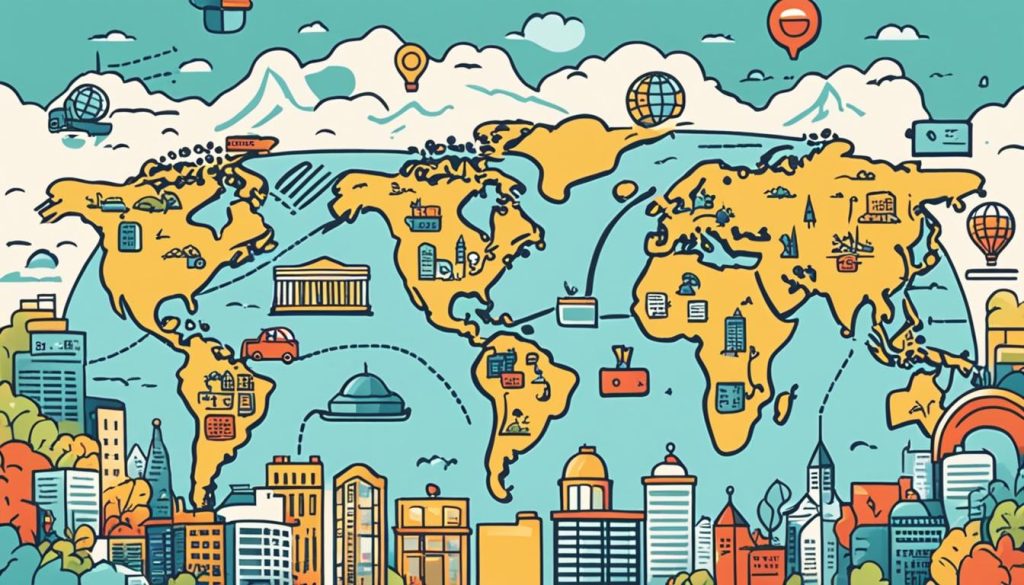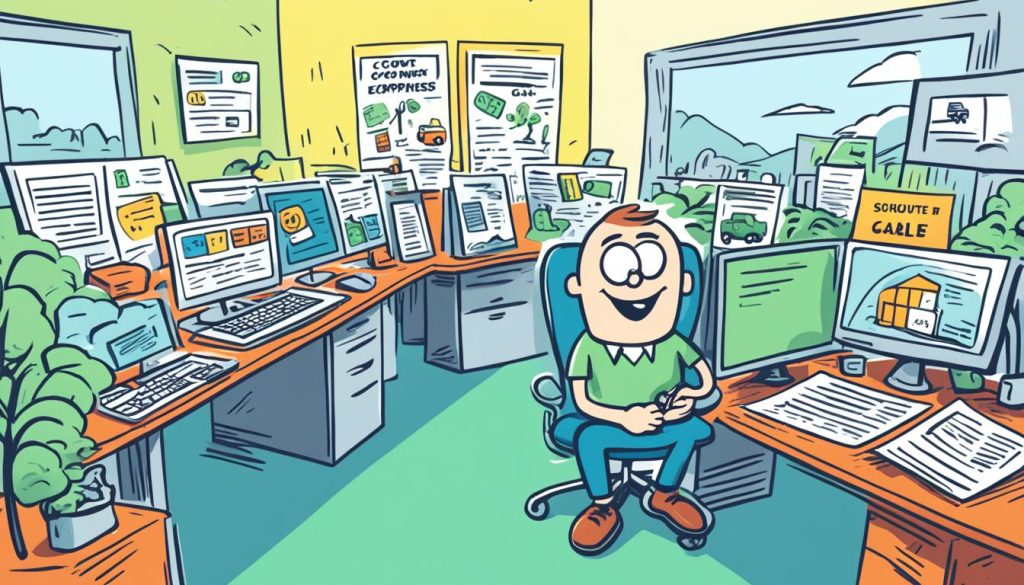The COVID-19 pandemic made working from home the new norm, starting with telecommuting in the 1970s during the oil crisis1. This change has cut down on commuting time, changing how people see their pay and work-life balance1. Now, when talking about jobs, people will likely discuss commuting needs, along with health benefits and pay.
For the past two years, many have enjoyed cheaper or no commute, saving money each month. This change has made workers rethink their pay and what they value in a job2. Studies show that working from home became more common because of COVID-19. It also links to better work performance and keeping employees happy1.
Key Takeaways
- The shift to remote work has reduced commuting time and costs for many employees.
- Future job negotiations will likely include office-commute requirements as a key compensation factor.
- Remote work has been increasingly adopted due to the COVID-19 pandemic, with connections to employee productivity and retention.
- Remote work is being increasingly considered as a strategy for organizations, especially in a post-COVID-19 world.
- Telecommuting was originally introduced in response to the oil crisis in the 1970s.
Introduction to Remote Work Economics
The Shift Towards Work from Home
The COVID-19 pandemic made remote work more popular1. Now, people work from home using technology to stay connected1. This change was made easier by digital tools and how businesses changed online1.
Working from home has many benefits for both workers and companies3. People working remotely often do better work than those in offices3. Companies save money on things like office space and equipment3. Plus, it makes workers happier and more satisfied with their jobs3.
Remote work affects more than just companies4. In 2020, a lot of new value was created in North America and Asia4. It lets companies hire people from all over the world for the right jobs3. It also helps businesses keep going even when unexpected things happen3.
Understanding remote work economics is key as we adjust to new work norms. Next, we’ll look at how remote work saves money, global trends, and its big economic effects.
The Economics of Remote Work: Saving on Commuting and Office Space
The shift to remote work has changed the game for businesses and individuals. It’s brought big savings on commuting and office space costs5.
Before the pandemic, remote work was rare, happening only a few days a week. But the pandemic made full-time remote work the norm. Now, companies like KPMG in Luxembourg let employees work from home most days, saving everyone time and money5.
Commuting costs add up, especially for long trips. Imagine cutting your commute to just 10 minutes. That means saving on fuel and time, too5.
| Metric | Pre-Pandemic | During Pandemic |
|---|---|---|
| Remote Work Adoption | 13% in Austria | 30-40% of total workforce |
| Productivity | Lower than office-based | Higher than office-based3 |
| Cost Savings | Limited | Significant for businesses3 |
| Employee Satisfaction | Lower than remote workers | Higher for remote workers3 |
Remote work isn’t just about saving on gas and rent. Companies can cut costs on office space, utilities, and gear3. It also helps them bounce back faster from tough times, like natural disasters or health crises3.
But, remote work has its own set of challenges, especially for women. Companies need to tackle these issues to make remote work fair for everyone6. By doing so, they can make sure all employees, no matter their gender or family situation, benefit from remote work6.
“Remote work arrangements can lead to cost savings for businesses by reducing expenses related to office space, utilities, and equipment.”3
Global Survey of Working Arrangements
Remote work’s economics have become more interesting as more people work from home. This shift brings big cost savings for both companies and workers. A recent worldwide survey shows how flexible work setups are doing in different countries6.
The survey looked at people aged 20-59 who finished primary school. It aimed to see how much time people save by working from home. It also looked at how people use this saved time. The survey was done twice, once in late 2021 and again in early 2022, in 27 countries6.
This survey showed some interesting things. It mostly looked at people with more education, mainly in middle-income countries. But, it still gives us a good look at how work is changing6.
The survey found that the pandemic really changed how people work from home. By 2020, about 30 to 40 percent of workers were working from home. Before the pandemic, in 2015, only 13 percent in Austria worked from home6.
It also showed different views on remote work among people. Mothers took on more family tasks during the pandemic. Fathers were more critical of not being able to work from home6. Women saw better focus and men saw more benefits outside of work6.
This survey gives us a good look at how remote work is changing. As we move past the pandemic, these insights can help make better work policies. They can help use the good parts of flexible work while solving problems for different workers651.
Time Savings and Allocation by Demographics
Remote work has changed the way people spend their time, especially by cutting down on their daily commute. Surveys show that daily commutes vary widely, from 51 minutes in Serbia to 102 minutes in China7. In the U.S., the average commute is 55 minutes7. This means people can save up to 72 minutes a day by working from home7.
Average Daily Commute Times
This extra time can greatly change how people manage their work and personal life7. Before the COVID-19 pandemic, working from home was seen as a way to better balance work and life7. But the pandemic made it a key way to keep businesses running and reduce the spread of illness7.
Thanks to digital tools and the digital shift in companies, remote work has become more common1. Research shows it can make employees more productive and likely to stay with a company1. Yet, it’s not clear if it should be a permanent option for everyone1.
People’s desire for flexible work varies by age and other factors. For example, many U.S. workers, especially millennials and Gen Z, might look for new jobs if they can’t work remotely2. Over half of U.S. workers who worked from home during the pandemic want to keep doing so2.
This shift to remote work has big economic effects, affecting how people balance work and life and how companies keep good employees7. If more companies keep using telework, it could change the job market, possibly moving jobs from big cities to places with good internet7.
In summary, how people use their time with remote work depends a lot on who they are and their experiences. Younger people and those who worked from home during the pandemic want more flexible jobs2. Knowing this helps companies manage their teams better and use remote work’s benefits7.
Economic Impact of Remote Work
Remote work has changed the economy a lot, especially by cutting down on commuting costs for workers. A McKinsey survey8 found that nearly two-thirds of U.S. workers want to work from home at least three days a week after the pandemic. This change could save a lot of money for both workers and companies.
Before the pandemic, Americans spent about 55.2 minutes each day going to and from work8. One in ten workers spent over two hours on their commute. Not commuting saves a lot of time, which is like getting a 10%-20% raise for those making over $30 an hour8. This could mean saving $7,000-$15,000 a year for each person.
Remote work also helps businesses save money. They don’t need big offices anymore9. Things like heating, internet, printing, and rent can be paid by the worker at home. This means big savings for companies, which they can use for other business needs.
But, not everyone gets the same benefits from remote work8. Over 40 years, U.S. workers have gotten 72% more productive, but their pay has only gone up 17%. Economists argue about why wages haven’t kept up with productivity. If companies keep most of the benefits, it could mean workers don’t see much gain from working remotely.
Yet, the job market is so tight right now that employers might not want to make remote workers’ jobs harder8. But, things could change when the job market gets back to normal. Employers might try to keep more of the remote work benefits for themselves.
In the end, remote work affects both workers and companies in many ways, with possible savings for both. As work changes, it’s important for employers and workers to work together. They need to make sure the benefits are shared fairly and that everyone sees the long-term perks of working remotely891.
Conclusion
The shift to working from home has become more important due to the COVID-19 pandemic. It has led to big savings on commuting and office space. People also enjoy more freedom, a better quality of life, and less environmental harm10.
But, remote work isn’t all smooth sailing. Things like worker demographics, family life, and mental health affect how well remote work works1112. Employers and workers need to tackle these issues to make remote work successful for everyone.
As we move past the pandemic, the economics of remote work will keep being key for businesses, policymakers, and us. By looking at the savings, productivity, and how it affects society, we can make the most of working online. This will help us build a better, fairer, and stronger future.
FAQ
How much time do workers save by working from home?
How do workers allocate their time savings from working from home?
How has the shift to remote work during the pandemic impacted businesses and the economy?
How will the shift to remote work affect future employment negotiations?
What are the other benefits of increased remote work beyond time and cost savings?
Source Links
- Remote Working and Task Innovativeness – an Integrated Resource Based View and Antecedent-Behaviour-Consequence Perspective – Information Systems Frontiers
- The moral economy of the great resignation – Humanities and Social Sciences Communications
- The Benefits of Hiring Remote Employees-Virtual Assistant Solution
- Digital Taxation around the World
- Vincent GS on LinkedIn: 🌟 The Evolving Landscape of Work: From Home Office to Office Building—A…
- Remote workers’ free associations with working from home during the COVID-19 pandemic in Austria: The interaction between children and gender
- The Battles To Come Over The Benefits Of Working From Home – Forbes India
- Organizational Support of Working from Home: Aftermath of COVID-19 from the Perspective of Workers and Leaders
- COVID-19, the Built Environment, and Health
- Bedroom-cum-office cubicle: Work from Home and Its Impact on Employees
- Frontiers | Remote workers’ free associations with working from home during the COVID-19 pandemic in Austria: The interaction between children and gender



